Hebben circulaire bouwoplossingen een positieve impact?
De circulaire bouwindustrie is bezig aan een opmars in Vlaanderen. De laatste tien jaar wordt circulariteit als dé strategie naar voren geschoven voor de transitie naar een duurzamere maatschappij. Maar hebben deze circulaire bouwoplossingen wel een positieve impact op het milieu en is deze ‘duurzamere’ manier van bouwen wel financieel haalbaar?
Van lineair naar circulair bouwmodel
‘’There is no planet B’’. De groeiende wereldbevolking en welvaart hebben het land-, grondstof- en waterverbruik aanzienlijk doen toenemen tot ongekende niveaus van vervuiling en aantasting van biodiversiteit. Tegenwoordig is de milieucrisis, letterlijk en figuurlijk, een hot topic.
De bouwsector heeft hierop een kolossale impact met zijn huidig lineair model, gaande van het ontginnen en produceren, tot het consumeren en elimineren van bouwproducten als afval. De noodzaak voor een transitie in de richting van een duurzamere bouweconomie is onmiskenbaar. Om deze overgang te realiseren, wordt de circulaire aanpak vaak naar voren geschoven. De circulaire bouweconomie, met een focus op hergebruik, richt zich op een langere benutting van bouwproducten door de levensduur te verlengen en het hergebruik te stimuleren aan de hand van een flexibele lay-out en reversibele connecties.
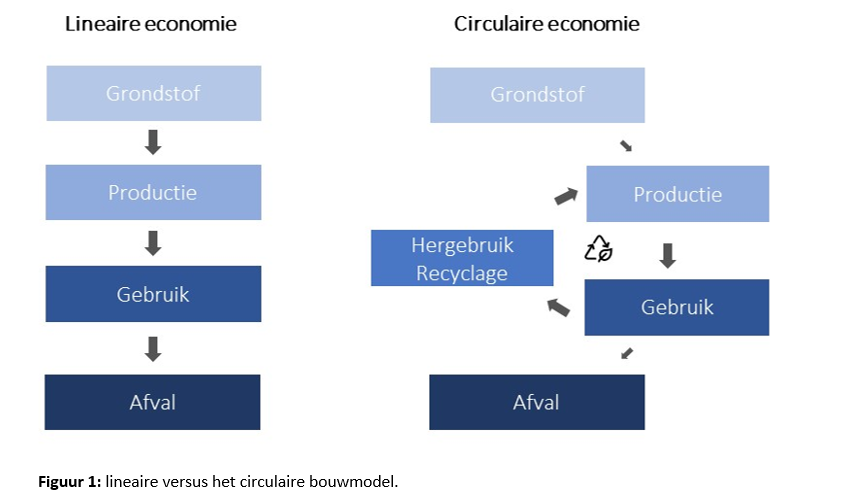
Circulariteit in cijfers
Zijn circulaire bouwoplossingen wel duurzamer dan klassieke bouwelementen? Momenteel zijn er maar een gering aantal onderzoeken die het duurzame karakter van circulaire bouwelementen aantonen. Daarenboven ontbreekt een consistente en door de overheid erkende methode om het hergebruikspotentieel te evalueren. Daarom wordt in dit onderzoek een evaluatiemethode onderzocht om de kosten en milieu-impact van circulaire en traditionele bouwelementen te vergelijken voor specifieke verbouwingsscenario’s in een gebouw.
Voor de vergelijking op gebied van milieu-impact is het belangrijk om de hele levenscyclus van het gebouw in rekening te brengen. Dat houdt de impact van de ontginning in, de productie, het transport, de constructie, vervangingen, verbouwingen, het onderhoud, de afbraakwerken en de afvalverwerking. Voorgaande onderzoeken identificeerden de levenscyclusanalyse (LCA) evaluatiemethode als een potentiële kandidaat. Hierbij worden alle processen en aannames gedurende de levenscyclus van het gebouw omgezet in een milieuscore die de impact van een bouwelement weergeeft. De traditionele LCA-methode, gemodelleerd volgens het lineaire bouwmodel, houdt helaas geen rekening met het hergebruikspotentieel. Daarom wordt in de masterproef de R-LCA methode geïntroduceerd, vertrekkend van de traditionele LCA methode. Hierin wordt het hergebruikspotentieel van circulaire bouwmaterialen meegerekend in de milieu-score van de verbouwingen. Om deze score te berekenen, wordt er een nieuwe berekeningsmethode geïntroduceerd voor circulaire bouwoplossingen, naast deze voor klassieke bouwelementen.
Naast de milieu-impact speelt ook het kostenplaatje een belangrijke rol. Het levenscycluskosten (LCC) kader is een vaak gebruikte methode voor kostenramingen in de bouwwereld. Hiermee worden alle kosten van een bouwelement gedurende de levensduur van een gebouw geïnventariseerd. Tenslotte kunnen dan de milieu-impact en kosten van circulaire bouwelementen afgewogen worden ten opzichte van traditionele bouwelementen om zo het meest duurzame element te bepalen.
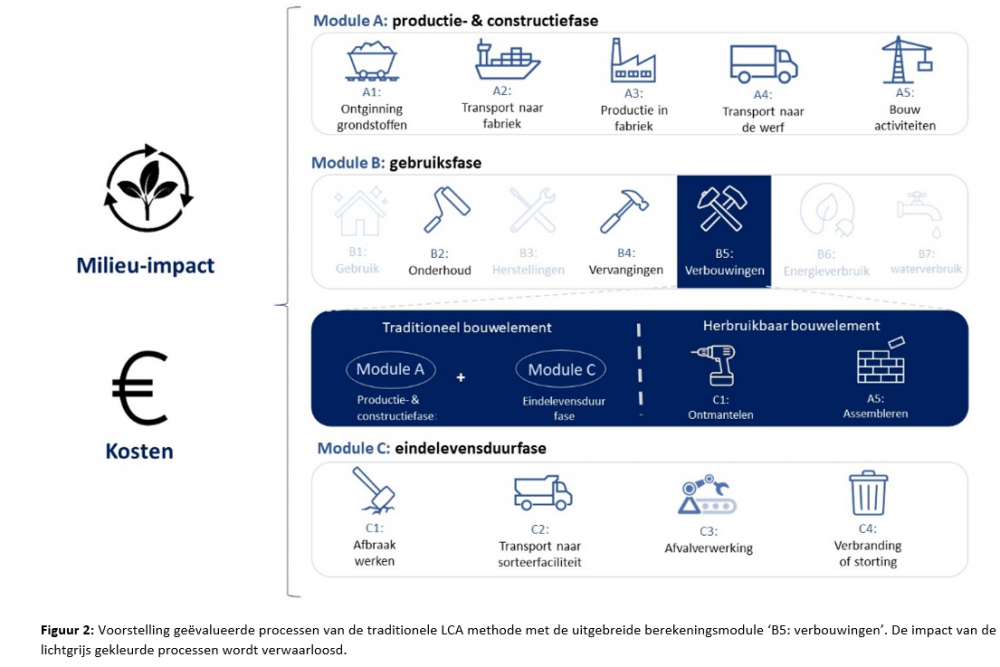
Circulaire versus traditionele wanden in het CBBW-project
De circulaire rijwoning in Berchem, gerealiseerd door TEKEN architectuur samen met MikeViktorViktor architects, BOUD, Systimber en Itho Daalderop, is deel van het ‘Circulair Bouwen, Betaalbaar Wonen (CBBW)’ project. Met dit project, gesponsord door Vlaanderen Circulair, wil men de brug slaan tussen de theorie en de praktijk van circulair bouwen.
In de pilootwoning worden circulaire JUUNOO wanden gebruikt. Daarbij rijst de vraag of deze wel duurzamer zijn dan klassieke binnenwanden voor dit bouwproject. Daartoe wordt de kost en milieu-impact van circulaire en traditionele binnenwanden vergeleken op basis van de bovenstaande methode gedurende de verwachte levensduur van de woning, namelijk 60 jaar. Vijf wanden worden onderzocht, namelijk de circulaire JUUNOO wanden met MDF of gipskarton, de natbouwwand en de droogbouwwanden met metal studs of houten draagstructuur.
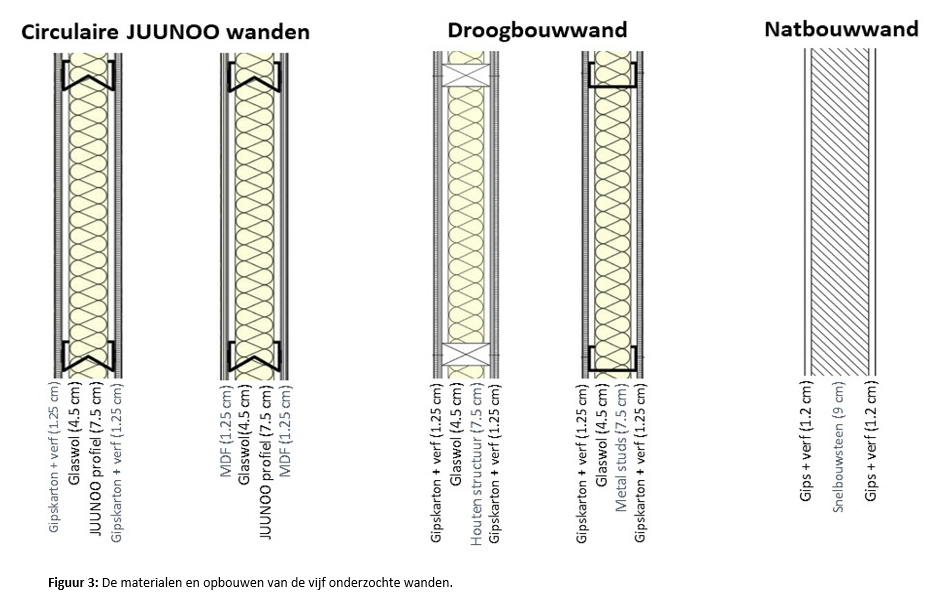
De totale milieu-impact en kosten van de binnenwanden in de pilootwoning worden bepaald aan de hand van verbouwingsscenario’s, gemodelleerd volgens een gebruiksverhaal. In deze verhalen veranderen de behoeften van een samenwonend koppel of breidt het huishouden uit, waardoor de woning moet worden aangepast. Vier hedendaagse scenario’s worden uitgewerkt, namelijk scenario 1 ‘koppel met gezinsuitbreiding’, scenario 2 ‘koppel met dokterspraktijk’, scenario 3 ‘koppel met hulpbehoevende ouder’ en scenario 4 ‘koppels co-housen’.
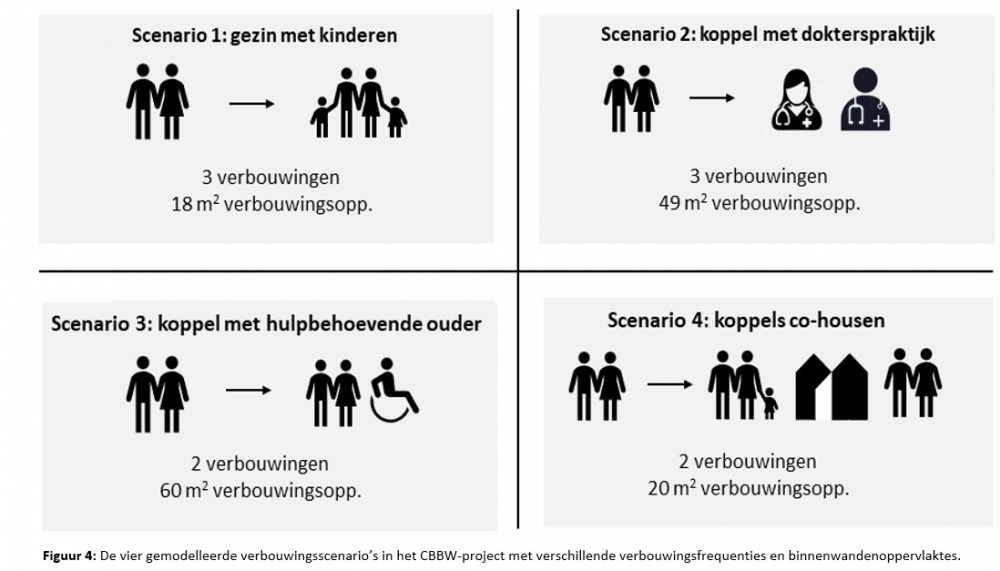
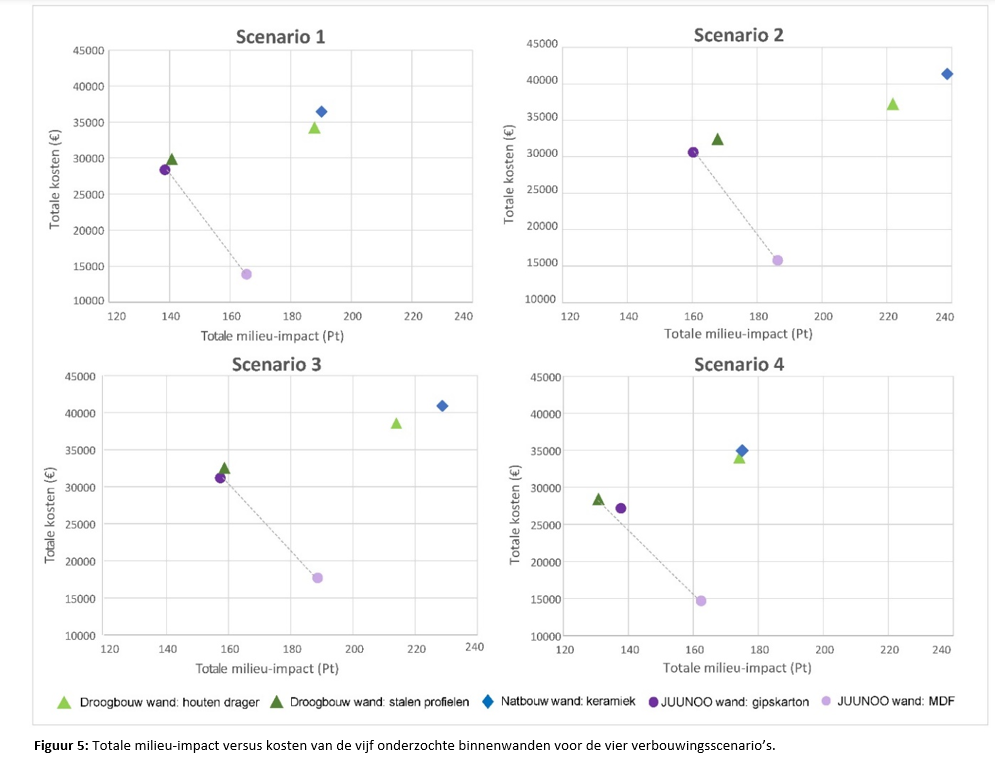
Figuur 5 vat de resultaten samen waarbij de totale kost en milieu-impact van de vijf binnenwanden met elkaar vergeleken worden. De JUUNOO wand met gipskarton heeft de laagste milieu-impact, behalve in het vierde scenario. In dit scenario heeft de droogbouwwand met metal studs een lagere milieu-impact door de lage verbouwingsfrequentie en kleine verbouwingsoppervlakte. Dit komt doordat traditionele staalprofielen slanker zijn dan JUUNOO profielen en uit minder metaal bestaan. Daarentegen wordt de milieu-impact van de circulaire JUUNOO wanden lager dan die van de traditionele wanden bij grotere en meer verbouwingen door het hergebruikspotentieel van de JUUNOO profielen. Toch blijft het verschil in milieu-impact klein tussen de JUUNOO wand met gipskarton en traditionele metal stud wand voor de vier scenario’s. Verder is de totale kost van JUUNOO wanden lager dan die van traditionele wanden. Alhoewel hun materiaalkost hoger is, valt de totale arbeidskost lager uit. Dit is een gevolg van de kortere (de)constructie tijd van JUUNOO wanden en de hoge arbeidskosten in België.
Besluit
De geïntroduceerde R-LCA en LCC methodes kunnen respectievelijk de milieu-impact en de kosten van circulaire en traditionele bouwelementen vergelijken in éénzelfde gebouw voor welbepaalde verbouwingsscenario’s. Deze methode wordt toegepast om in het CBBW project de duurzaamheid van de gebruikte JUUNOO wanden af te toetsen tegenover traditionele binnenwanden. Uit de studie blijkt dat het gebruik van circulaire JUUNOO wanden voordeliger wordt bij een stijgende verbouwingsfrequentie en verbouwingsoppervlakte. Wanneer er weinig tot geen verbouwingen plaatsvinden, heeft de traditionele metal stud wand een lagere milieu-impact. De verwachte verbouwingen voor de onderzochte bouwtypologie zijn vrij beperkt. Daaruit rijst de vraag of rijhuizen wel goede potentiële kandidaten zijn voor circulaire bouwoplossingen.
Bibliografie
ABEX indexen. (2021). Retrieved 2021-12-19, from https://www.abex.be/nl/indexen-abex/
Allacker, K. (2010). Sustainable building: the development of an evaluation method (Un- published doctoral dissertation).
Allacker, K., De Backer, W., Delem, L., De Nocker, L., & De Troyer, F. (2018). Environ- mental Profile Of Building Elements.
ASPENindex: Nieuwbouw. (2019). Antwerpen.
Azevedo, S., Godina, R., & Matias, J. (2017). Proposal of a Sustainable Circular Index for Manufacturing Companies. Resources, 6 (4).
Balanay, R., & Halog, A. (2019). Tools for circular economy: Review and some poten- tial applications for the Philippine textile industry. In S. S. Muthu (Ed.), Circular Economy in Textiles and Apparel. Woodhead Publishing.
Barn, M. (2017). With resource use expected to double by 2050, better natural resource use essential for a pollution-free planet.
Beauclerque, J. (2020). Naar een circulaire economie in de bouw.
Benachio, G. L. F., Freitas, M. d. C. D., & Tavares, S. F. (2020). Circular economy in the construction industry: A systematic literature review. Journal of Cleaner Production, 260 .
Benetto, E., Becker, M., & Welfring, J. (2009). Life Cycle Assessment of Oriented Strand Boards (OSB): from Process Innovation to Ecodesign. Environmental Science & Technology , 43 (15).
Berners-Lee, M. (2019). There Is No Planet B.
Bocken, N. M. P., de Pauw, I., Bakker, C., & van der Grinten, B. (2016). Product design and business model strategies for a circular economy. Journal of Industrial and Production Engineering , 33 (5), 308–320.
Brandt, S. (1995). How Buildings Learn: What happens after they’re built. New York: Viking.
Brown, A., Haas, D. W., Laubscher, M., Pallecchi, A., Reh, F., Rietveld, E., . . . van, K. (2018). The CIRCULARITY GAP report: an analysis of the circular state of the global economy (Tech. Rep.).
Brundtland, G. H. (1987). Our Common Future (Tech. Rep.). United Nations.
Brunner, P. H., & Rechberger, H. (2004). Practical handbook of material flow analysis.
The International Journal of Life Cycle Assessment , 9 (5).
Buildings and constructed assets — Service life planning — Part 1: General principles and framework (Standard). (2011). International Organization for Standardization.
Buyle, M., Galle, W., Debacker, W., & Audenaert, A. (2019). Sustainability assessment of circular building alternatives: Consequential LCA and LCC for internal wall as- semblies as a case study in a Belgian context. Journal of Cleaner Production, 218 .
Cambier, C., Galle, W., & De Temmerman, N. (2021). Expandable Houses: An Explorative Life Cycle Cost Analysis. Sustainability , 13 (12).
Cayzer, S., Griffiths, P., & Beghetto, V. (2017). Design of indicators for measuring product performance in the circular economy. International Journal of Sustainable Engineering , 10 (4-5), 289–298. (Publisher: Taylor & Francis)
Circulair Bouwen Betaalbaar Wonen. (2020). Retrieved 2021-10-23, from https://www.circulairbouwenbetaalbaarwonen.com/team-1
Coelho, M. C., & Almeida, D. (2015). Cycling Mobility – A Life Cycle Assessment Based Approach. Transportation Research Procedia, 10 .
Corona, B., Shen, L., Reike, D., Rosales Carre´on, J., & Worrell, E. (2019). Towards sus- tainable development through the circular economy - A review and critical assessment on current circularity metrics. Resources, Conservation and Recycling , 151 .
Daniotti, B., Lupica Spagnolo, S., & Paolini, R. (2008). Factor Method application using factors’ grids.
Debacker, W., Allacker, K., & De Troyer, F. (2012). Milieugerelateerde materiaalprestatie (Tech. Rep.).
De Nocker, L. (2018). Annex: Monetisation of the MMG method.
Desmyter, J. (2001). De milieu-impact van bouwmaterialen en gebouwen: een bijkomend criterium in het keuzeproces.
De Valk, E., & Quik, J. (2017). Eenduidig bepalen van circulariteit in de bouwsector.
De Wolf, C., Hoxha, E., & Fivet, C. (2020). Comparison of environmental assessment methods when reusing building components: A case study. Sustainable Cities and Society , 61 .
Di Maio, F., Rem, P. C., Bald´e, K., & Polder, M. (2017). Measuring resource efficiency and circular economy: A market value approach. Resources, Conservation and Recycling ,122 , 163–171.
Durmisevic Elma. (2006). Transformable building structures. Design for dissassembly as a way to introduce sustainable engineering to building design & construction. (Unpub- lished doctoral dissertation).
Eberhardt, L. C. M. (2020). Qualifying Circular Economy in Building Design Practice: Developing Life Cycle Assessment Design Concepts that Support Implementation of Circular Economy in the Building Sector. Aalborg University Press.
Eberhardt, L. C. M., Birgisd´ottir, H., & Birkved, M. (2019, August). Life cycle assessment of a Danish office building designed for disassembly. Building Research & Informa- tion, 47 (6), 666–680.
Elkington, J. (2008). The Tripple Bottom Line. In Environmental Management: Readings and Cases. SAGE.
Environmental management — Life cycle assessment — Principles and framework (Stan- dard). (2006). International Organization for Standardization.
Environmental management — Life cycle assessment — Requirements and guidelines
(Standard). (2006). International Organization for Standardization.
European Commission. Joint Research Centre. Institute for Environment and Sustain- ability. (2010). International Reference Life Cycle Data System (ILCD) Handbook
:general guide for life cycle assessment : detailed guidance. LU: Publications Office. EuropeanCommission. (2014). Eco-efficient construction and building materials: life cy-
cle assessment (lca), eco-labelling and case studies (No. no. 49). Philadelphia, PA: Woodhead Pub.
European Commission. (2019). Eurobarometer 2020.
European Commission. (2020). European commission report. Retrieved 2021-11-20, from https://ec.europa.eu/info/news/focus-energy-efficiency-buildings-2020-feb-17 en
Evolutie van de prijzen van niet-energetische industri¨ele goederen en diensten in Belgi¨e na de heropening van de economie. (2021). Instituut voor de nationale rekeningen.
Farjana, S. H., & Li, W. (2021). Integrated LCA-MFA Framework for Gold Production from Primary and Secondary Sources. Procedia CIRP , 98 .
Fogarassy, C., Horvath, B., & Kovacs, A. (2018). A Circular Evaluation Tool for Sustain- able Event Management – An Olympic Case Study. Acta Polytechnica Hungarica, 14 (7).
Foster, G. (2020). Circular economy strategies for adaptive reuse of cultural heritage buildings to reduce environmental impacts. Resources, Conservation and Recycling , 152 .
Franklin-Johnson, E., Figge, F., & Canning, L. (2016). Resource duration as a managerial indicator for Circular Economy performance. Journal of Cleaner Production, 133 , 589–598.
Friedman, A. (2002). The adaptable house. Toledo, USA: OwlsBooks.
Geissdoerfer, Savaget, Bocken, & Hultink. (2017). The Circular Economy – A new sus- tainability paradigm? Journal of Cleaner Production, 143 , 757–768.
Ghisellini, P., Cialani, C., & Ulgiati, S. (2016). A review on circular economy: the expected transition to a balanced interplay of environmental and economic systems. Journal of Cleaner Production, 114 , 11–32.
Gluch, P., & Baumann, H. (2004). The life cycle costing (LCC) approach: A concep- tual discussion of its usefulness for environmental decision-making. Building and Environment , 39 .
Goedkoop, M., Oele, M., Ponsioen, T., & Meijer, E. (2019). Introduction to LCA with SIMAPRO.
Graedel, T. E. (2019). Material Flow Analysis from Origin to Evolution. Environmental Science & Technology , 53 (21).
Griffiths, P., & Cayzer, S. (2016). Design of Indicators for Measuring Product Performance in the Circular Economy. Sustainable Design and Manufacturing 2016 , 52 , 307–321.
Gul, W., Khan, D. A., & Shakoor, D. A. (2017). Impact of Hot Pressing Temperature on Medium Density Fiberboard (MDF) Performance. Advances in Materials Science and Engineering , 2017 .
Haag, D. (2017). Circulaire economie: wat we willen weten en kunnen meten.
Haas, M., Leeuw, R. K., & van Luijk, P. (2011). Levensduur van bouwproducten. SBR.
Hart, J., Adams, K., Giesekam, J., Tingley, D. D., & Pomponi, F. (2019). Barriers and drivers in a circular economy: the case of the built environment. Procedia CIRP , 80 , 619–624.
Haupt, M., K¨agi, T., & Hellweg, S. (2018). Modular life cycle assessment of municipal solid waste management. Waste Management , 79 , 815–827.
Haupt, M., Vadenbo, C., & Hellweg, S. (2017). Do We Have the Right Performance Indicators for the Circular Economy? Journal of Industrial Ecology , 21 (3), 615– 627.
Hellweg, S., & Mil`a i Canals, L. (2014). Emerging approaches, challenges and opportunities in life cycle assessment. Science (New York, N.Y.), 344 , 1109–1113.
Himpe, E., Trappers, L., Holm, M., Janssens, A., Delghust, M., Debacker, W., & Moens,
J. (2012). Life cycle energy use of a zero-energy house.
Hossain, M. U., & Ng, S. T. (2018). Critical consideration of buildings’ environmental impact assessment towards adoption of circular economy: An analytical review. Journal of Cleaner Production, 205 , 763–780.
Howarth, R., & Norgaard, R. (1992). Environmental Valuation under Sustainable Devel- opment. American Economic Review , 82 , 473–77.
Huyghe, X. (2022). Interview JUUNOO walls: LCA and LCC study. Jannsens, A. (2013, October). Levenscyclusanalyse of LCA. JUUNOO. (2019). JUUNOO: Algemene bestekbeschrijving.
Kaza, S., Yao, L. C., Bhada-Tata, P., & Van Woerden, F. (2018). What a Waste 2.0: A Global Snapshot of Solid Waste Management to 2050. Washington, DC: World Bank.
Kirchherr, J., Reike, D., & Hekkert, M. (2017). Conceptualizing the circular economy: An analysis of 114 definitions. Resources, Conservation and Recycling , 127 , 221–232.
Laner, D., & Rechberger, H. (2016). Material Flow Analysis. In M. Finkbeiner (Ed.), Special Types of Life Cycle Assessment (pp. 293–332). Dordrecht: Springer Nether- lands.
Laso, J., Garc´ıa-Herrero, I., Margallo, M., V´azquez-Rowe, I., Fullana, P., Bala, A., . . . Aldaco, R. (2018). Finding an economic and environmental balance in value chains based on circular economy thinking: An eco-efficiency methodology applied to the fish canning industry. Resources, Conservation and Recycling , 133 , 428–437.
Lauwers, F. (2022). Interview: arbeidskosten in de bouw.
Lei, H., Li, L., Yang, W., Bian, Y., & Li, C.-Q. (2021). An analytical review on application of life cycle assessment in circular economy for built environment. Journal of Building Engineering , 44 , 103374.
Leising, E., Quist, J., & Bocken, N. (2018). Circular Economy in the building sector: Three cases and a collaboration tool. Journal of Cleaner Production, 176 , 976–989.
Linder, M., Sarasini, S., & van Loon, P. (2017). A Metric for Quantifying Product-Level Circularity: Product-Level Circularity Metric. Journal of Industrial Ecology, 21 (3), 545–558.
Macarthur Foundation, E. (2016). Material Circularity Indicator. Retrieved 2021- 11-08, from https://ellenmacarthurfoundation.org/material-circularity-indicator
Maes. (2021). Containers Maes - prijzen containerservice 01/01/2020. Retrieved 2022- 04-13, from https://www.containersmaes.be/index.php/nl/
Manfredi, S., Allacker, K., Pelletier, N., & de Souza, D. M. (2010). Product Environmental Footprint (PEF) Guide.
Meadows, D. H., Meadows, D., Randers, J., & Behrens, W. W. (1972). The Limits To Growth: a report for the CLUB OF ROME’S (Tech. Rep.).
Miernyk, W. H. (1966). The Elements of Input-Output Analysis. Economica, 33 (132). Minunno, R., O’Grady, T., Morrison, G., Gruner, R., & Colling, M. (2018). Strategies for
Applying the Circular Economy to Prefabricated Buildings. Buildings, 8 (9), 125.
Mouligneau, B. (2021). Hefbomen voor een transitie naar een circulaire economie: fi- nanciering.
Obrecht, T. P., Jordan, S., Legat, A., Ruschi Mendes Saade, M., & Passer, A. (2021, De- cember). An LCA methodolody for assessing the environmental impacts of building components before and after refurbishment. Journal of Cleaner Production, 327 , 129527.
OECD. (2008). Measuring material flows and resource productivity.
OECD. (2012). Environmental outlook to 2050: the consequences of inaction. International Journal of Sustainability in Higher Education, 13 (3).
Ohnishi, S., Dong, H., Geng, Y., Fujii, M., & Fujita, T. (2017). A comprehensive evaluation on industrial & urban symbiosis by combining MFA, carbon footprint and emergy methods—Case of Kawasaki, Japan. Ecological Indicators, 73 , 513–524.
OpenStructures. (2014). Modular grid: the fractal grid. Retrieved 2022-02-18, from https://www.openstructures.net/about
OVAM. (2015). 24 ontwerprichtlijnen voor veranderingsgericht te bouwen. Overconsumption? our use of the world´s natural resources (Tech. Rep.). (2009). SERI. Paduart, A. (2012). Re-design for change: a 4 dimensional renovation approach towards a dynamic and sustainable building stock (Unpublished doctoral dissertation).
Paduart, A., De Temmerman, N., Trigaux, D., & De Troyer, F. (2013). Casestudy ontwerp van gebouwen in functie van aanpasbaarheid: Mahatma Gandhiwijk Mechelen.
Park, J. Y., & Chertow, M. R. (2014). Establishing and testing the “reuse potential” indicator for managing wastes as resources. Journal of Environmental Management , 137 , 45–53.
Pater, L. R., & Cristea, S. L. (2016, June). Systemic Definitions of Sustainability, Dura- bility and Longevity. Procedia - Social and Behavioral Sciences, 221 , 362–371.
Pauliuk, S., Kondo, Y., Nakamura, S., & Nakajima, K. (2017). Regional distribution and losses of end-of-life steel throughout multiple product life cycles. Resources, Conservation and Recycling , 116 , 84–93.
Peters, R., Bauwens, D., & Van Den Driessche, C. (2014). Hoeveel Kost de Hervorming van Kinderbijslag? Retrieved 2022-04-29, from https://www.vrt.be/vrtnws/nl/2014/03/24/hoeveel kost de hervormingvandekinderbijslag-1-1916643/
Planbureau, F. (2019). Economische vooruitzichten 2019-2024 (Tech. Rep.). Instituut voor de Nationale Rekeningen.
Pomponi, F., & Moncaster, A. (2017, February). Circular economy for the built environ- ment: A research framework. Journal of Cleaner Production, 143 , 710–718.
Rajagopalan, N., Brancart, S., De Regel, S., Paduart, A., Temmerman, N. D., & Debacker,
W. (2021). Multi-Criteria Decision Analysis Using Life Cycle Assessment and Life Cycle Costing in Circular Building Design: A Case Study for Wall Partitioning Sys- tems in the Circular Retrofit Lab. Sustainability , 13 (9), 5124.
Romn´ee, A., & Vrijders, J. (2018). Naar een circulaire economie in de bouw: inleiding tot de principes van de circulaire economie in de bouwsector.
Ruimte Vlaanderen Opsplitsen of Zorgwonen. (2017). Retrieved 2022-04-29, from https://www.omgevingsloketvlaanderen.be/opsplitsen
SBR. (2011). SBR - 2011 - Levensduur van bouwproducten.
Smith, D., & Jones, S. (2019). Circularity indicators: an approach to measure circularity.
Statbel. (2018). Arbeidskosten volgens activiteit | Statbel. Instituut voor de nationale rekeningen.
Statbel. (2021). Evolutie van de prijzen van niet-energetische industri¨ele goederen en diensten in Belgi¨e na de heropening van de economie. Instituut voor de nationale rekeningen.
Surgenor, A., Winch, R., Moodey, L., & Mant, A. (2019). Circular economy guidance for construction clients: How to practically apply circular economy at the project brief stage (Tech. Rep.). Londen, UK: UK Green Building Council.
Sustainability of construction works - Assessment of economic performance of buildings
(Standard). (2015). International Organization for Standardization.
Sustainability of construction works - Assessment of environmental performance of build- ings (Standard). (2012). International Organization for Standardization.
Sustainability of construction works - Environmental product declarations (Standard). (2019). International Organization for Standardization.
SWRA. (2016). Calculating a Recycling Rate.
Thiebat, F. (2019). Life Cycle Design: An Experimental Tool for Designers. Springer. UNEP. (2021). Emissions Gap Report 2021: The Heat Is On – A World of Climate
Promises Not Yet Delivered (Tech. Rep.). Nairobi.
Vandenbroucke, M. (2016). Design, dimensioning and evaluation of demountable building elements (Unpublished doctoral dissertation).
Van Looy, J. (2017). Gemeenschappelijk wonen en nieuwe woonvormen. Retrieved 2022-04-29, from https://www.vlaanderen.be/gemeenschappelijk-wonen-en-nieuwe-woonvormen
van Stijn, A., Malabi Eberhardt, L., Wouterszoon Jansen, B., & Meijer, A. (2021, November). A Circular Economy Life Cycle Assessment (CE-LCA) model for building components. Resources, Conservation and Recycling , 174 , 105683. doi: 10.1016/j.resconrec.2021.105683
Verberne, J. (2016). MCI en BCI (Unpublished doctoral dissertation). Vermeulen, W. J., Reike, D., & Witjes, S. (2019). Circular Economy 3.0.
doi: https://doi.org/10.1016/j.resconrec.2017.08.027
Verstegen, J. (2019). Uniform maatsysteem MOSARD. Retrieved 2021-11-22, fromhttps://www.mosard.be/m-maatsysteem/
Vlaamse Overheid. (2019). GRO.
Waldo, G. (2016). Scenario Based Life Cycle Costing, an enhanced method for evaluating the financial feasibility of transformable building (Unpublished doctoral dissertation).
Wastiels, L., Delem, L., & Dessel, J. (2013). To module D or not to module D? The relevance and difficulties of considering the recycling potential in building LCA.
Withanage, S. V., & Habib, K. (2021). Life Cycle Assessment and Material Flow Analysis: Two Under-Utilized Tools for Informing E-Waste Management. Sustainability (14). Retrieved 2022-02-18, from https://www.mdpi.com/2071-1050/13/14/7939
World population prospects (Tech. Rep.). (2017). United Nations. Re- trieved 2021-11-19, from https://www.un.org/development/desa/pd/sites/ www.un.org.development.desa.pd/files/files/documents/2020/Jan/un 2017 world population prospects-2017 revision databooklet.pdf









